If you are thinking of buying a piano to upgrade your skill level, here’s a comprehensive review that lists the 10 best digital pianos for intermediate pianists. Some of the basic aspects that one must bear in mind when purchasing a digital piano include its length, size, number of keys, variety of sounds, brands, portability, and weight. These reviews are based on exclusive features, functions, popularity, and value for your money. This way, you can conveniently choose a model that benefits your skill level and other preferences.

Let’s take a look at the top-rated Digital Pianos For Intermediate Level Pianists.
Quick Summary: Best Intermediate Digital Pianos 2024
Also check:- Best Sounding Digital Pianos
Top 10 Best Digital Pianos for Intermediate Pianists
1. Yamaha P125 Digital Piano – Best Overall
Pros
- Packed with 50 songs in the built-in library and 20 different rhythms
- The improved speaker system provides an incredible sound effect facilitating on-stage performance
- The smart-pianist app enables allowing more scope to pianists
- 192 notes-polyphony is a good range for intermediate players
- 24 sound options make the Yamaha P125 a high-grade instrument
- Sustain pedals ensure continuous resonance not breaking the flow
- Best electric pianos with weighted keys too
Cons
- No furniture bench included
- No Bluetooth connectivity
Yamaha P125 is an 88-key weighted keys action digital piano packed with features to satiate your musical quest. A simple and compact model, this one from Yamaha is compact and blends high-end performance with its user-friendly interface. Enduring a sleek appearance, the piano promises powerful sound. The touch response and dynamic features make this a player’s favorite electric piano.
Offering an authentic piano-like experience the Yamaha P125 is enabled with an unbeatable stereophonic sound that will give your performance a rich feel. The Pure CF sound engine engineered on this model reverberates sound like the concert grand piano. 4 layers sampling enables a smooth transition between samples.
Features
- Graded Hammer Standard keyboard Piano with 88-keys provides a heavier touch in the base and lighter touch in the higher end, similar to an acoustic piano
- The two-speaker system generates a stereophonic sound.
- The instrument is controllable via your smart device. Intermediate pianists can improve their skills by selecting preferable voices and rhythms. The Yamaha P125 digital piano is compatible with Yamaha’s smart pianist app.
- 4 reverbs Chamber, Recital Hall, Concert Hall, and Club.
- The bass and drum tracks are pre-installed in the system which enables the user to conveniently follow the harmony, rhythm, and pace of play. It offers a dozen rhythm patterns such as rock, pop, ballads, and more to make your practice sessions fun and real-time.
- The table EQ feature provides the comfort of placing the piano on any surface without disrupting the sound. The internal speakers ensure optimized sound.
Must Check: Best Digital Pianos: Top 15 Pianos to Buy in 2024
2. Casio Privia PX-770 – Console Digital Piano for Intermediates
Pros
- The AiR engine offers highly accurate grand sounds for expressive and powerful performance.
- Its dual-mode design splits the piano into two equal pitch ranges for piano lessons.
- Connects with the Chordana Play app for iOS and Android devices.
- The powerful stereo amplification system for optimal listening experience.
Cons
- The keyboard of this piano is a little mushy.
- The sounds of the piano are very low.
This is an excellent budget piano from the legendary Casio brand. The look of this piano is awesome and is also very compact for small rooms and studio apartments. The first look of the piano gives the impression that this is a professional piano with a very sleek and modern design. It looks beautiful but is heavy and you will need assistance to set this piano. The Casio PX-770 belongs to the renowned Privia family of pianos from Casio and offers a true and grand piano experience in its slim and modern design.
We can experience authentic piano sound and natural sound in this brilliant instrument for awesome performances. The piano has a slim design and has several impressive features for a natural feel. The Casio PX-770 is a brilliant instrument that features replicated ivory and ebony keys. This digital piano helps in ambient concert play and it comes with a built-in library of classical pieces, offering the ability for the players to play along with the recordings of the live symphony orchestra.
This piano has a compact and slimline space-saving design and features a compact design with three pedals, full-size keys, and an exceptional sound system for rendering a grand experience for all.
Its tri-sensor scaled hammer action keyboard piano features a slim design and supports expressive and natural performances. It is possible to connect the piano to a Mac or Windows device without the need for drivers through class-compliant USB.
Check out: Best Casio Digital Pianos in the Market
3. Yamaha P515 – Most Realistic Intermediate Digital Piano
Pros
- Natural wooded keyboards are created by making use of unrivaled expertise for decades.
- Samples from the renowned CFX and Bosendorfer grand pianos.
- Exceptional speaker system with astonishing clarity.
- Compatible with the smart pianist app.
Cons
- The pedal is not of good build quality
- The heavy piano requires assistance.
If you ever wanted to try the Bosendorfer Imperial piano samples and the Yamaha CFX, you got to get the Yamaha P515, as it couples the sounds of the world’s finest and most prominent concert grand pianos to instill the music interest in you. The best feature that we found in this piano is that it allows the users to choose from diverse acoustic and piano settings, to help create one’s piano playing experiences.
The reason that this piano can reflect the sounds of the concert grand piano perfectly is through its virtual resonance modeling technology that helps in the perfect reflection of limitless sounds of concert grand pianos. Its natural wooded keyboards and pertinent hammer action keys with escapement and synthetic key tops help us to have the natural response and feel of a concert grand piano. The key-off samples of this piano help deliver the delicate changes in the sound and the total number of polyphony in this piano is about 256.
This piano has more than 500 voices and helps with a wide selection of sounds to choose from, allowing us to perform almost in any music genre. The P-515 features two advanced technologies that allow users to enjoy realistic and natural sounds even when heard through headphones.
The piano has a very powerful speaker system and its 15w speakers with 5w amplifiers render an immersive and authentic piano experience.
Check out: Best Digital Pianos Under $1500 For a Realistic Sound Experience
4. Roland FP-30 – Best Roland Intermediate Keyboard
| Features | Rating |
| Performance and sounds | 9.5 |
| Lightweight | 9.1 |
| Connectivity | 9.1 |
| Build Quality | 9.3 |
| Value for money | 9.5 |
Pros
- Rich and responsive piano tones from Roland’s SuperNATURAL sound engine
- Compact and lightweight for easy portability
- Twin piano mode for learning side-by-side piano lessons
- Powerful speakers for an impressive sound
Cons
- The keys of the piano are quite heavy and demand additional force.
This is an excellent piano from Roland that packs the rich and renowned acoustic sounds of the grand piano. You will love the authentic piano touch of its 88-note ivory action keys, which helps with maximum expression for a thorough piano-playing experience. Apart from a good playing experience, it also delivers an impressive sound performance with its stereo speakers and a powerful amplification system.
We can enjoy playing this piano at any time of the day, without having to disturb others as it is compatible with headphones and also renders a very quiet keyboard action. And the piano features powerful stereo speakers and amplifiers that help in delivering impressive sound quality. We also get an optional matching stand and a three-pedal unit with this piano from Roland for enhanced functionality. It is also compatible with some sheet music apps, that enhance the functionality of the piano and helps with a hands-free page-turning experience as well.
The piano is extremely compact and lightweight and helps in easy mobility, both in and out of the home, studio, or classroom. You will love its built-in Bluetooth connectivity feature that connects the piano with powerful apps on the tablet or smartphone.
You also get to expand your music-playing experience with this piano with its split and dual modes, wherein you can select several non-piano sounds, such as the sounds of the drums, voices, strings, etc., for a complete music performance. There is also an option to connect with USB memory to save the songs.
5. Casio PX-S3000 – Best Casio Intermediate Piano
Pros
- Features multi-dimensional AiR sound engine for rich and reminiscent sounds
- Its acoustic simulators help in expressing the real sounds of the grand piano
- Simulated ebony and ivory keys that offer ease of playing with optimal fingertip fit.
- Connects with Bluetooth and Chordana app.
Cons
- The speaker’s sound has distortion.
This is an exceptional 88-key stage piano with 192-note polyphony and the feature that we loved the best in this piano is its smart scaled hammer action keyboard and its myriad of onboard effects. The piano is capable of rendering about 700 sounds and 200 rhythms. The piano comes with an on-and-off pedal with a music stand, but it doesn’t come with a dedicated stand for the piano itself.
If you want us to describe this piano in a word, we would say this is an authentic piano that offers the best feel and sound and also renders a wealth of tones and rhythms to explore on the go. This is one of the slimmest hammer action digital pianos available in the world and has been built by making use of compact construction technologies. Thus, the Casio Privia PX-S3000 is at least 20% slimmer than its predecessors and its wedge-shaped case features a slim design.
Its simple and stylish design helps the piano with its superior playability and the clear and glossy finish of the piano offers it a flat design with no protruding and disturbing buttons. Its LED operation panel is easy and intuitive to play and it comprises graphical touch sensors for an authentic playing experience. The simple design of the piano allows the pianist to play efficiently by concentrating on the performance rather than on the controls.
6. Donner DDP-100 – Best Budget Intermediate Piano
Pros
- Weighted 88-keys can train the ability of the players to distinguish sound and develop ambient musical intonation.
- Adapted DREAM sound source offers realistic sound quality presenting smooth and fine high notes.
- Exceptional function with the three pedals
Cons
- The weighted keys are slightly stiffer than the other pianos.
This can be a great piano for beginners as well as intermediates and it is shipped with a furniture stand, triple pedals, power adapter, and everything to say playing soon after unboxing and assembling. The piano comes with a power adapter, triple pedals, and an 88-key fully weighted keys digital piano that precisely matches the finger strength changes, offering a more stable and better piano feel. The sounds of this piano are more realistic and excellent and help beginner and intermediate piano players to develop a keen ability to play distinguished sounds.
The built-in speakers and amplifiers of this piano help in supporting external sounds and it stays compatible with the headphone as well. The piano has a streamlined design and its wooden cabinet features a sliding key cover to protect the keys. Donner DDP has 128 polyphonies and features pure tone samples from real acoustic grand pianos, guaranteeing the quality of performance and practice.
Its AWM dynamic samples help in producing richer, broader, and deeper sounds, and its DREAM sound source helps in analyzing realistic sound quality for completely presenting smooth and fine notes and rich low notes. This is a lightweight piano that weighs only 45 kg and its body material comprises medium-density fiberboard that is portable and lightweight
Also Check: Best Budget Digital Pianos Under $500
7. Casio PX-360 – Editor’s Choice For Intermediates (Under $1000)
| Features | Rating |
| Performance and sounds | 9.4 |
| Light weight | 8.9 |
| Connectivity | 9.1 |
| Build Quality | 9.1 |
| Value for money | 9.5 |
Pros
- Possible to save the recordings directly to the USB stick to create stunning recordings
- Duet mode allows two people to play the piano simultaneously.
- Portable and lightweight piano
- The built-in speaker system helps with exceptional sound quality.
Cons
- Has too many features that are hardly used by the players.
The Casio PX 360 belongs to the affordable, highly functional, and portable Privia Line series from the Casio family. Its best features are its multi-dimensional AiR sound, redesigned speaker system, and Tri-Sensor Scaled hammer-action keyboard piano. Its control panel looks simple and easy to navigate, good enough to understand, and be operated by an amateur pianist. The controls are for volume, recording features, and main piano sounds including the metronome.
The PX 360 has an 88-key fully weighted keyboard band with keys that are of the same size as that regular pianos. The fully weighted keys trigger the hammer action on the strings as that acoustic pianos. The triple sensor system of the keys detects the intensity and velocity of the individual keypresses and alters the timbre and the volume of the tunes accordingly. The piano can produce the sound of 18 instruments including grand pianos, strings, organs, E. pianos, bass, and harpsichord.
The Piano includes 550 Tones and we can play from expressive basses and guitars to play drums and strings and a lot more offering a polished look and feel for the players.
You can accompany your guitar-playing experience with more than 200 rhythms that cover a wide range of musical styles in the piano or also use the rhythm editor to customize the piano-playing experience. You can carry this piano seamlessly for all your stage performances, as it is lightweight and portable and weighs merely 26 pounds.
Check out: Best Digital Pianos Under $1000
8. Yamaha DGX-660 Digital Piano – Good Choice for Home
| Features | Rating |
| Performance and sounds | 9.6 |
| Easy to Assemble | 9.6 |
| Connectivity | 9.2 |
| Build Quality | 9.3 |
| Value for money | 9.6 |
Pros
- The weighted keyboard piano allows for customization
- The GHS feature is great for intermediate-level players
- The piano room function enables selecting from a variety of sounds
- 192-note polyphony is great for players who want to take it to the next level of professional play.
- Packed with a range of voices and effect settings
- The microphone enables singing and recording.
- MIDI connectivity and USB enabled
Cons
- Not a lightweight model. This impedes its portability
A versatile digital piano, the DGX660B from Yamaha provides the customizable sounds and effects that an intermediate-level player seeks to upgrade her skills. The interactive features of this high-grade piano make learning and playing music fun. Also, accessibility to Yamaha’s website and apps enhance the experience.
DGX660B creates the sound of the grand piano with its piano room feature and also allows users to select from a range of other instruments. You’ll love the acoustic settings as they enable the creation of a customized piano environment.
The furniture stand provides users an additional comfort of height. The instrument can be connected with a microphone enabling users to sing along as they play their choicest compositions using digital effects. The built-in speakers add to the sound quality replicating the full-band playing experience. The USB audio recorder device makes recording possible.
Features
- Professional reverb and chorus effect enhances the sound manifold times recreating the effects of performing on a stage
- The microphone enables recording and saving your tracks with the best-suited effects
- Enabled with the Pure CF Sound Engine, this piano from Yamaha generates the sound of the authentic concert grand piano.
- The Graded Hammer Standard keyboard is designed to deliver weighted action. Just like the acoustic piano effect, at its bass, you get the heavier touch while at the upper end, you can feel the lighter touch.
- The LCD screen on Yamaha DGX660B is great to view the lyrics, and notations from any MIIDI tracks that you play on the instrument.
- The songs downloaded from Yamaha MusicSoft to any USB device connected to the piano can be viewed and played conveniently.
- Accompaniment style creates the impact of a virtual band as with the Smart Chord you just need one left-hand finger to be placed to create any chord from pop to jazz and more.
Check out: Best Home Digital Pianos 2024
9. Yamaha YPG535 Digital Piano – Great Alternative for Intermediates
| Features | Rating |
| Performance and sounds | 9.6 |
| Connectivity | 9.2 |
| Portability | 8.5 |
| Easy to Assemble | 9.6 |
| Build Quality | 9.3 |
| Value for money | 9.6 |
Pros
- Full range of 88-keys
- Lightweight (24 lbs) and portable
- Touch-sensitive and offers 3 preset settings
- Offers 500 instrument sounds
- Comes with a stand
- Can be connected to external devices; a range of options available at the rear of the instrument
Cons
- Semi-digital piano weighted keys don’t provide the hammer action
- 32-note polyphony may not be the best available for intermediate players
- Can only operate on AC power
Intermediate pianists looking for a digital piano that echoes the sound of a grand piano will love the Yamaha YPG535. This model provides a sound quality akin to the authentic piano. The piano comes with a quality furniture stand. The semi-weighted 88-keyboard measuring 53.75″ is good enough for beginners but doesn’t provide the rebounding acoustic effect.
The size of the YPG535 digital piano is perfect to fit into any corner of your apartment. It has a sleek design and is lightweight which makes this piano portable. The compact keyboard features a dozen of sound effects. This piano can be assembled conveniently and makes for a popular choice to perform with.
There is a button dedicated to every function and setting on the YPG535 piano and allows players to enjoy the grand piano tone by pressing the “portable grand” button.
Features
- This Yamaha digital piano model offers a monochrome display (320X240)
- Designed with the graded soft-touch action keyboard piano
- AWM stereo sampling technology
- This Yamaha keyboard is enabled with a 2-way speaker system that divides the sound into two parts providing a well-balanced, impactful treble and bass in both high and low registers.
- Dual mode allows users to enjoy layered sounds from two different instruments upon pressing a key each time.
- The split mode splits the keyboard into two halves turning this one-piece piano into two teacher-student duet modes.
- It comes with a 6-track MIDI recorder. This allows users to record up to 5 songs and also save them in the instrument’s flash memory.
- 160 accompaniment styles enable booster performance with multiple-instruments
- Metronome-equipped keyboard fosters ease of practicing rhythm and pace
- Phone drive, USB to host, USB to the device, sustain pedal jack.
Check out: List of Best Yamaha Digital Pianos 2024
10. Yamaha YDP103 – Great Yamaha Digital Piano, Electric Piano for Intermediate Player
| Features | Rating |
| Performance and sounds | 9.6 |
| Connectivity | 9.2 |
| Easy to Assemble | 9.7 |
| Build Quality | 9.2 |
| Value for money | 9.6 |
Pros
- The ivory and ebony keys enable a smooth touch and feel and are great for users who want to practice for a longer duration.
- Sturdy build with a sleek look
- The electric piano provides a grand piano life effect
- Great for intermediate players
- High-quality finish
- Offers values for money
Cons
- Split function and lesson mode is missing
- No playback facility
- MIDI connectivity absent
Scouting for a digital piano that’s sleek, classic, and provides an enchanting sound? Here’s the YDP103 Arius Series piano from Yamaha. The dark rosewood color adds to its majestic appearance while the technology provides the best acoustic experience to users. This is one electric piano model you will cherish running your fingers on.
Just like any other Yamaha piano, this one speaks volumes about its high-end quality. It is designed with 88 keys, 3 pedals, a graded hammer effect, and a score of features to suit the style of any intermediate-level pianist seeking to improve his skill. The hammer impact adds a heavier touch to the bass keys and a lighter feel in its higher-end rippling the acoustic effect.
This model of electric piano comes with a pedal that creates a rich sound quality just like the grand piano. The damper pedal makes sure that every note echoes the acoustic sound. YDP103 Arius is slightly bulky which is a downside of this otherwise well-featured digital piano. On the contrary, the design and the color are an add-on to its merits.
Features
- 88 weighted keys deliberating graded hammer action. The GHS facilitates building an appropriate finger technique required to play an acoustic piano.
- YDP103 Arius has an advanced wave memory synthesis that offers a realistic sound akin to a grand piano.
- 64-polyphony with 10 different instrument sounds included
- Ivory and ebony matt keytops for comfortable play. It prevents slipping of fingers
- It comes with a half-damper pedal that allows users to enjoy sustained notes by pushing it down.
- Furniture styled bench included with the set offers the comfort of sitting and playing the instrument well.
- It allows combining two sounds to make a unique combination.
- The digital piano controller app enables connectivity with smartphones or tablets.
- The instrument can be connected to a PC or mobile device using a standard USB cable.
Check out: Best Digital Pianos & Keyboards for Beginners
Specifications Required for Intermediate Players
Things to look for in a piano for an intermediate pianist are as follows:
The Acoustic Quality
Pre-recorded acoustic piano sounds are used to create the sound of the digital piano. The sound quality of these recordings is influenced by the recording process and equipment employed. The sound of a decent digital piano should resemble that of an acoustic piano as nearly as possible. There are many different pianos out there, and it is crucial to find one that you enjoy playing.
Additionally, you should pay close attention to the articulation and decay—the beginning and end—of the sound, as well. Digital pianos with more precise control over articulation and decay produce a more realistic sound.
The Number Of Keys
There are 88 keys on a standard grand piano. While some digital pianos have fewer than 61 keys, others have more than a hundred. A piano with 88 keys is essential for more experienced pianists to play at their highest level. A full-sized piano, on the other hand, is recommended for beginners who are serious about learning to play the piano.
Three-part Harmonies
At any given time, a piano can produce as many distinct notes as possible, known as polyphony. With 32-note polyphony, a piano can simultaneously play 32 notes. Polyphony of at least 64 is recommended for intermediate musicians. A piano with at least 128-note polyphony is recommended for more experienced pianists.
Why would a piano with 128-note polyphony exist when a full-sized piano has 88 keys? This is a common misunderstanding. This is because the sustain pedal enables the piano to play a large number of notes simultaneously. The piano may produce more than 88 notes if you use the sustain pedal to play an extended series of notes.
Sensitivity
Touch sensitivity refers to the piano’s ability to respond to varying levels of intensity when you play a key. When you press a key, the keyboard can tell how fast you’re pressing it, and it responds by adjusting the loudness of the sound. For musicians who want to express themselves musically, a touch-sensitive piano allows them to do so.
The Keys’ Weight
Semi-weighted and fully-weighted keys are available on digital pianos. Weighted keys, like those seen on an acoustic piano, are becoming increasingly popular among keyboard manufacturers. With fully-weighted keys, a digital piano with an acoustic-like keyboard is the finest alternative. Musicians considering the purchase of an acoustic piano may find this to be an excellent alternative.
The Sounds Of Other Instruments
A digital piano can mimic the sound of practically any instrument, from a saxophone to a whole choir, with its wide range of sounds. It isn’t necessary, but a piano with a big number of instrumental tracks will allow you to choose the tone that best suits your song.
Learner Aids
Dual-mode, which divides the keyboard into two portions so that you can play in the same octave as an instructor or a buddy, illuminated keys In the beginning, these elements serve as learning aids. Although not all learning tools are helpful, Thus, it is essential to pick a piano that has additional characteristics that fit your needs.
Identifying a Product or Service
The sound quality and longevity of a digital piano can be predicted by looking at the model nameplate on the instrument. Certain digital piano brands have been repeatedly recommended by specialists in the field for their dependability.
Digital Pianos For Intermediate Players
For intermediate musicians, digital pianos are unquestionably a good learning tool. People who purchase intermediate digital pianos typically have advanced beyond those who purchase beginner digital pianos. Those with beginner digital pianos are normally only interested in learning the most basic concepts like note letters, chords, and simple compositions first.
Intermediate musicians have a broader understanding of music theory and most likely have written a few compositions even. They want a machine that will provide them with more features and capability than a novice slab, without being as intrusive and difficult as some expert machines. A great number of pianos that are classified as intermediate level have hammer action technology systems, a greater variety of rhythms and tones, as well as more functionality and connectivity options to other types of platforms.
Tips To Move From Beginner To Intermediate Level
To be able to move from beginner level to intermediate level a player must do the following things to enhance his skills.
Progressions of the chords
The 1-5-6-4 progression, for example, can be played in multiple keys and inversions by an intermediate guitarist. Diatonic chords and how to use them in chord progressions should also be known to them. And an intermediate pianist can use fills and riffs to enhance the musicality and impact of these progressions.
Technique
Scales, arpeggios, and triads are what I’m referring to when I say technique. To play all the white key signatures, an intermediate player must first master the C major scale and its relative minor triads and arpeggios (C-D-E-F-G-A-B). Intermediate musicians need to know the three types of minor scales. In addition, they should be able to recognize a major or minor triad by ear and be able to construct all four types of 7th chords that are used in music. To play them in root position, however, they should be able to play them in any order, including inversions.
Repertoire
There are songs that every musician needs to have in their repertoire in case they are ever called upon to perform for a crowd. You should be prepared to perform at least three songs as a beginner, but an intermediate should be able to perform at least 10 songs. People will often ask you to play something if they learn that you play the piano. While this may be difficult for some, I believe it is essential. The time has come for you to prepare! No need to memorize these ten songs, but they should be well-rehearsed and ready for performance.
Theory of Music
The theory is something that many people dread, but an intermediate pianist needs to have at least a basic grasp of it. This necessitates familiarity with the various scale formulas and how they are constructed. The students should also have a basic understanding of rhythm, note values, and time signatures. The ability to read music is another aspect of theoretical proficiency. You’ll need to study the music notation and figure out how to play it to do this. Even if they can’t play it right away, at the very least, they should be able to identify the notes and symbols.
Rhythm and Emotiveness
This is the most important point, which is why I’ve saved it for the end. Intermediate players are capable of playing dynamically and evoking a strong emotional response from the audience. Identifying a beginner is easy because they usually only play at one volume and it’s usually quite loud. By controlling the piece’s dynamics and feel, intermediate pianists, engross listeners emotionally.
You Might Also Like
- Roland FP30X: Best Portable Digital Piano Review
- Korg D1: Best Digital Piano Review
- Top 6 Best Piano Learning Apps For Android & iOS
- Top 10 Best Piano Keyboard Stands for Standing
- Top 7 Best Piano Keyboard Stands
Concluding Thoughts
The above-reviewed digital pianos for intermediates are the 10 best picks that you can consider in your effort to enhance your pianist skills further. All these digital pianos can mimic the sound of a real piano. You can select any model that fulfills your preference for sound and effects.
Frequently Asked Questions (FAQs)
How Often Should One Work on His Skills?
The answer is every day, but only for a short period. There are no shortcuts when it comes to learning to play the piano. 20 minutes a day is a good starting point. Short practice sessions don’t have to take up a lot of time; simply schedule them whenever it’s most convenient for you. We also understand that life doesn’t always go according to plan, so it’s okay if you only get to play five days out of seven in a week.
How Can I Make My Fingers More Flexible and Dexterous?
When it comes to your hands, fingers, and wrists they are just like any other group of muscles, bones, and tendons in your body. Exercise is by far the quickest and most effective way to improve agility and flexibility. For the simple reason that they work, scales have been the primary method for weighing for hundreds of years. Flowkey has tutorials on how to use scales.
The Hanon exercises are an excellent alternative for improving finger and wrist flexibility, speed, agility, and strength. As outlined in Charles Louis Hanon’s book, “The Virtuoso Pianist in 60 Exercises,” there are exercises for beginners, intermediate players, and advanced players. You can get them for free in a variety of online locations.
Playing the songs you love will also improve your flexibility and dexterity over time. Songs that use the techniques you want to learn and practice are great tools for learning and practicing. It’s just a matter of being persistent and patient enough. Getting the results you want may take months, but that is perfectly fine. You can speed up your progress by incorporating some of the above ideas into your practice routine.
Should I Buy an Acoustic Piano or a Keyboard?
What kind of piano you should have in your home depends on how much space you have and what you want to do with your music. A good digital keyboard is perfect for people who need to be able to take it with them, are on a tight budget, or want to try out different sounds. If you’re serious about music, have a lot of space in your house, and like the rich sounds of an acoustic instrument, you should buy one. Acoustics also need to be tuned and taken care of regularly to keep their tone and touch. To know the difference between the two, read our article:
What’s a Good Price for a Piano?
How much you should spend depends on how much money you have, what you want, and how skilled you are. Beginners can play on a used spinet, upright, or good-quality digital piano with no problems. Intermediate pianists should play on an upright or baby grand, while advanced pianists will need the features of a baby grand or grand.



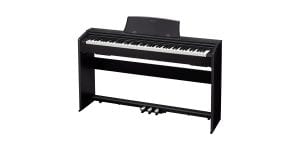

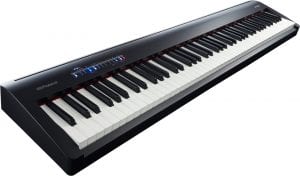
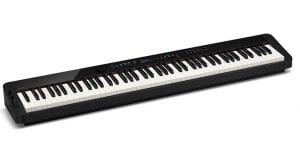
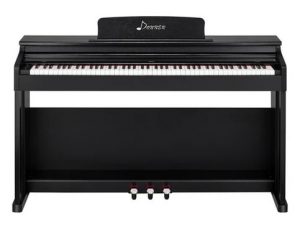
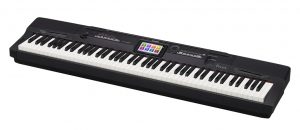

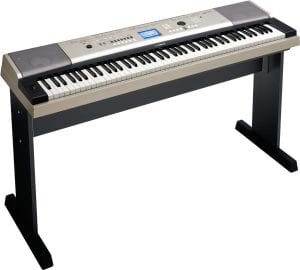
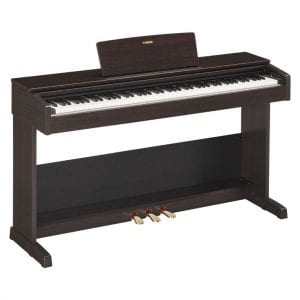
Being an intermediate and choosing a digital piano is always tough because when you are a beginner you can take advice from other pianists, but when you reach an intermediate level, you tend to get an idea what you want, but with so many options available in the market, it becomes difficult to pick one. But after a lot of research and reading these best intermediate-level digital piano reviews, I came to a decision that Casio Privia PX-160 will be the best option for me to go forward. It will not only help me grow as an intermediate, but it will also be a long term option as I won’t need to change piano when I reach the advance level.